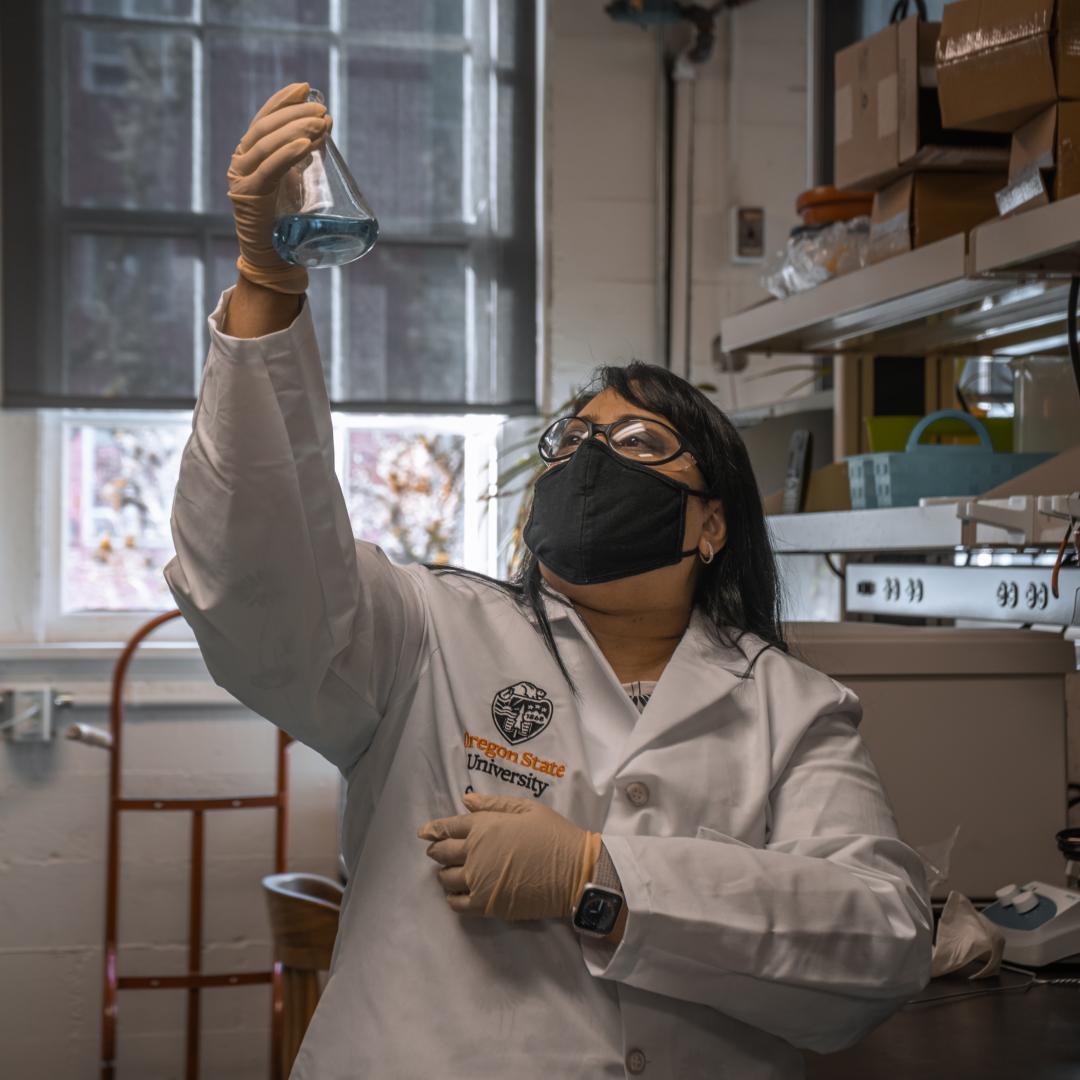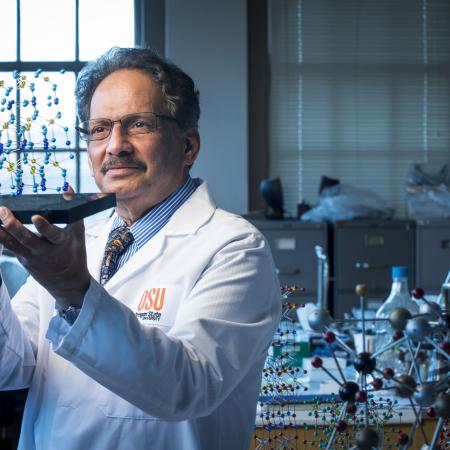Vibrant particles with purpose
The CAREER Award supports a long-running project that uses innovative biomaterial to address knowledge gaps in ophthalmology – particularly as related to age-related macular degeneration (AMD). Caused by deterioration of the central portion of the retina, AMD is the leading cause of vision loss in the world.
While AMD is currently considered an incurable disease, previous animal studies have shown that stem cells can be transformed into retinal cells and injected into the eye as a possible cure for blindness. Presently, the limiting factor continues to be a lack of technology to track stem cell migration and survival in the eye to determine the treatment’s long-term efficacy.
“The retinal layer in the eye is darker than any other layer because there are millions of retinol pigment cells which contain melanin,” said Mackiewicz. “We need to design something that is much more reflective than the melanin in order to be able to see the nanoparticle-labeled therapeutic cells if we want to track their survival and cell migration.”
“It’s pretty exciting for the whole group to be able to work on advancing new materials. We are right at this cutting edge where we’re blending chemistry and biology and engineering at the same time.”
In collaboration with OHSU ophthalmology professors David Huang and Renee Ryals, Mackiewicz developed gold nanoparticle-based probes that could bind to stem cells and provide enough contrast that the movement of single cells could be detected using optical coherence tomography (OCT). Developed by Huang, OCT is a non-invasive test that uses light waves to take detailed pictures of the retina and is currently used in millions of procedures around the country.
“When you make one of these nanomaterials, typically you’re starting with a colorless solution and as you add a reducing agent to make the nanoparticle, they change into something very intensely colorful and beautiful,” said Mackiewicz. “Gold nanoparticles are always red, like fine wine.” Silver nanoparticles are shaped as spheres, rods, or triangular plates, creating vibrant solutions that appear yellow, purple, teal or blue.
To stabilize the nanomaterials, Mackiewicz applies a patented coating that gives the material unique properties. This allows them to adhere to the therapeutic stem cells and provides protection against biological degradation or rejection by the immune system.
While gold and silver nanoparticles worked effectively when the stem cells were isolated in a gelatin matrix, they were insufficient to deal with the complexities of a living eye. But these preliminary results proved that their vision was possible. Mackiewicz just needs a more reflective nanomaterial.
The NSF CAREER Award may provide the means to realize this possibility: “We’ve shown that some of our newly designed nanomaterials are very safe both in cells and in zebrafish embryo models with Dr. Stacey Harper, a toxicology professor at OSU. And we are going to use that design strategy to code other types of materials that could be even more reflective,” she said.
Mackiewicz will have the funding to develop and test new materials that could yield even better results, such as titanium or silica. “Designing these new types of reflective materials is important because there isn’t an OCT contrast agent that exists,” she said. “If we could do this, we would be able to design the first type of contrast agent for OCT imaging, which could apply not only to retinal stem cell work, but to other types of diseases.”
“It’s pretty exciting for the whole group to be able to work on advancing new materials,” she said. “We are right at this cutting edge where we’re blending chemistry and biology and engineering at the same time.”
A student-centered teaching philosophy
Since arriving at Oregon State last fall, Mackiewicz has dedicated herself to providing opportunities for chemistry students that hadn’t existed when she herself was in college. “I always think of my students first because I remember what that’s like,” she said. “Working with first-generation and underrepresented students helps me remember who I am.”
In the form of two novel one-credit courses, she provided opportunities for students to gain important life skills that are often expected but rarely taught. “They learned to assess strengths and areas for improvement, innovation styles, inclusive leadership, working in teams, negotiation, networking, and how to read the scientific literature – one of the key skills to developing strong scientific identities,” she said. “And the students and come back and tell the class what is the state of the art in the field right now. And here is where this research in an area is headed.”
At the end of the term, she hosted a networking event for students who had taken the two courses where they met different faculty and industry partners. Students had the option to learn more about different career pathways and the labs they might want to do research in.
The CAREER Award secures funding to support and advance these programs, as well as outreach initiatives that will help connect high school students with nanomaterials research.
“We hope that these types of courses not only gives students professional development skills, but builds their sense of belonging in the department,” she said.
Other science faculty supported by NSF CAREER Awards include Elise Lockwood (Mathematics); Chong Fang, Paul Cheong and David Ji (Chemistry); and Bo Sun, Ethan Minot and Davide Lazzati (Physics).





